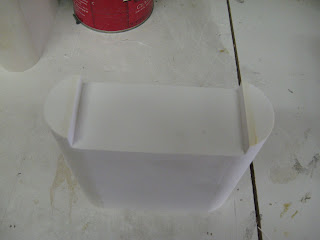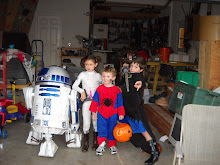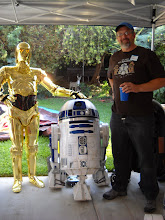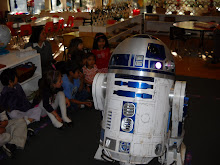
After searching around town in every hardware store, plumbing supply, and lumber yard, I found some PVC that's about 3" outside diameter. It's really 2.87 or so, but there don't seem to be any true OD 3" pipes in America unless you special order some metric pipe from overseas or something. I'm not that patient. So on with the battery boxes.
I set up the band saw with the fence and a board on the other side (unlike the posed picture here), and sliced the pipe down the middle. No special tricks here other than trying to keep the blade from drifting and trying not to let the cut corkscrew in the pipe. I snapped a chalk line on the pipe, but I still had some drift. I actually cut the pipe all at once, also unlike the picture, and then I cut cross sections to fit the blueprint specs. These half pipes will form the end caps on the battery boxes.

Then, after figuring out the dimensions I'd need, I cut some side plates. Useful tip: Once I got my table saw crosscut jig set to cut the pipe lengths, I cut the lengths on these side plates at the same time. That way the end caps and sides are exactly the same dimension.

And I cut some bottom pieces. I carefully shaped out one piece to fit and then used it as a template for all the others. Then I sanded the curves onto them on the belt sander. My sander can flip up to 90 degrees so you can set your piece on the table and sand the edges. Very handy feature for this sort of thing. Again, Grizzly tools rock. I got this big ass sander from them several years ago. It's 220 volts, 6 inches wide, and 40 inches long, or something, and it completely rocks. I could grind down a car with it if the need arises. But that also means that I have to be very gentle with fragile plastic pieces like these.

Once I had all the pieces cut, I started gluing. I improved my PVC glue technique a lot here, and killed a lot of brain cells breathing fumes. On the side plates, I cut some 1/2" wide strips and glued them inside with half of them overhanging the edges. This overhang would go over onto the half pipe pieces. Sorry, no picture. That way I had a good gluing surface for the joint, and so that the half pipes and the side plates weren't just butt glued together. I also found that once I had slathered on PVC cement onto one of the gluing surfaces, the trick was to press the two pieces together--not too hard--quickly get them alligned, and then just hold them perfectly still for 20 seconds or so. That let's the cement get an initial setup. I would just lay the pieces aside than and try not to handle them at all for a few hours. The label says that the bond strengthens a lot in 24 hours and that seemed to be right.
Speaking of labels, I a few years ago when I was building something, I had a revelation. This is going to sound stupid--because for 20 years I was stupid about it--but if you just read the damned directions on the label of stuff, or the manufacturer instructions, you'll get a wealth of accurate information that will make the difference between a project that is a failure and one that is a complete success. On the flip side, the place you should not be getting any advice about how to build something is from some snot nosed, dumb ass 17 year old who works at Home Depot and why has never swung a hammer in his life. No offense if you are a snot nosed, 17 year old dumb ass who's never swung a hammer.
And while I am on the topic, the one question that every hardware store employee, lumberyard troll, or counter help asks and that drives me completely insane is, "What's it for?" That is, you come in asking for a piece of foam rubber, or some 1/4" PVC sheet, or, God forbid, a piece of pipe that has an outside diameter of 3", and the first thing they say is "What's it for?", as if whether or not they have will depend on what you're building. I resist the urge to say, "none of your goddamned business," and just try to get them to tell me where it is without my having to explain WHY I am building my own scratch built, fully remote control R2D2. If you tell them that that's why you need the item, they you're less likely to get them to tell you where the pipes are or whatever.
Ok, I'll settle down.

When are started on this phase of the project, I realized that the setup for the battery box parts was most of the battle, and that I could crank out pieces for more of them than I need while I was at it. So at each point, once I was set up I cut enough to make 5 pairs of boxes. I had it in the back of my head that I could sell these to the builder's group if there is interest. I've learned a lot from reading about everyone's experiences and some people might not have some of the tools I have. So email me if you want to buy a pair. I'll have pictures of the end result posted shortly.
A few other notes. As I was designing my cutting plan for the pieces, I tried to build them so that all of the edges that would need to be trimmed would be on the outside, instead of on inside corners. That way, I could easily get to them with the sander and save myself a lot of work.
Once all of the pieces--I think there are 14 total--were glued together, I roughed out the curves on the top with the band saw to save my having to sand too much material off. Then I finished the job with the sander. That worked out pretty well. I have started to put primer on one pair and it looks like they'll need a minimum of filling into any gaps between the pieces. More news on those shortly.
I'm looking ahead to building the shells for the outer feet. I got some 1/4" ABS plastic sheeting from Interstate Plastics today (www.Interstateplastics.com). I think that will be sturdier than the expanded cell foam PVC that I used on the center foot.
And I have been reading all the accounts on the web that I can find about the way people have constructed drive systems in the feet. There are some really ingenious systems out there from people with much better engineering skills than me. Jerry Green's drive systems are incredible, and I think they are selling for over a $1,000 now. As usual, Victor Franco and Mike Senna have come up with some really neat solutions to these problems.
Here are some initial thoughts. I think I want to use as much of the full length of the outer feet--14 inches--as I can for a long wheel base for my R2. That is, I want to try to put two wheels into each outer foot, and put them as far apart as I can. I think that will add to stability, and make the unit rock around less when he's moving. I don't want him rattling, bouncing, or tipping. But of course, the shells get shorter as you got out to the edges, so that limits things. For the same reasons, I am wondering about using the widest possible wheels I can find for the job. A lot of the wheels people are using are 5 inches or so high, and maybe only 1.5 inches wide. I am going to try to scrounge up some wider wheels. I would even sacrifice some diameter on the wheels, I think, for some breadth. But maybe someone should argue me out of that. I figure that wide wheels will help make him stable and ride smooth. But I know that bigger diameter will make it easier to get over door sills and things. I'll have to experiment with that, and I'll have to go through the McMaster-Carr catalog.
I'm also wondering about maybe setting the motor up to be direct drive instead of chain drive. But I know that there are serious space limitation issues with the shells and the battery boxes. A lot of builders are hiding their motors inside the battery boxes. I'm not CAD adept, but I am good at intuiting what will work and what won't once I get the materials and parts in front of me and get my hands on them.
I'm also thinking about ways to engineer an aluminum frame for all these motor/wheel/chain contraption that will integrate well with the shells and use the space effectively. Since I am building the shells now, I can design in some features to tie them to the drive train chassis. I am also hoping that I can figure out a way to effectively fabricate/bend/join aluminum. I've learned a lot from Dan Baker's method, and Franco's and others. I'll buy a brake from Harbor Freight tools if I have to, but maybe I can do better. When I roofed and installed gutters and aluminum siding years ago, we always had these big fancy brakes that could put all kinds of complicated bends into the materials. If I could only get my hands on one of those again.
More soon.
MM




























































